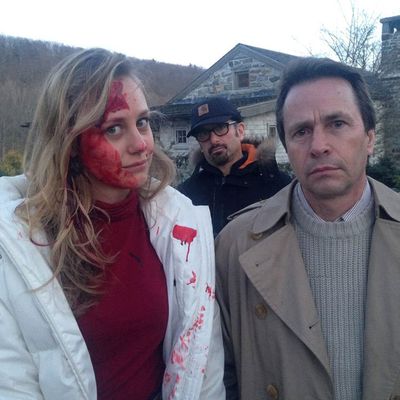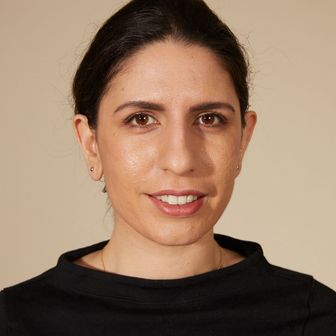
For all the praise going around for The Jinx’s ending to end all endings, one bone of contention has lingered throughout the documentary’s six-episode run: its reenactments of the murders of Kathie Durst, Susan Berman, and Morris Black. The deceased exist in parallel universes onscreen: in real-life photos and videos, and in highly aestheticized rehashings that imagine their final moments. According to Chelsea Gonzalez, who acts as Kathie Durst’s stand-in, the scenes were huge productions, meticulously shot on-and-off over two years. Most often, they would film at director Andrew Jarecki’s home in upstate New York, where Kathie’s family and friends would drop by now and then to observe the process. Vulture spoke to Gonzalez about the ins and outs of being a reenactor, working with Jarecki, and what it was like meeting Kathie’s family.
How did you get involved with The Jinx? What was the casting process like?
It was mostly cast off of them taking pictures of us, and asking a few questions. I was told by Andrew [Jarecki] later that when he saw my picture he freaked out because he told me that I looked just like Kathie Durst.
Had you done anything like this before, or was this a new experience for you?
It was definitely a new experience as an actor [to do reenactments], but the shoot was unbelievable, and I’ve actually been shooting it for the past two years. We shot so much stuff, not even a quarter of it ended up in the documentary. Also, nobody knew what we were shooting.
Did you know much about whom you were portraying?
Yes, and Andrew was great; he was very good at explaining the story and what was going on. We actually filmed most of it at Andrew’s house in upstate New York. So we did this three-day shoot, and we all thought that was the end, and then a couple days later, they would call me back and be like, “Oh, hey, we’re going to add another two days.” Then, two years later, every time I thought it was the last one we were going to do, they would call me back for another one. So I ended up working two weeks total.
Did you feel uncomfortable acting out these scenarios, knowing what the subject matter was?
It was weird, because I met a lot of Kathie’s family and friends. It was more because they wanted to see a movie set, and Andrew said, “Yeah, come check it out.” But it was weird for me because they would always say, “Oh, you just look so much like Kathie.” So it was a little creepy. But Andrew’s been absolutely amazing. I moved to Los Angeles pretty recently, and he set me up with meetings with certain production companies. He’s just such a good person.
Did Kathie’s family and friends seem at all bothered or troubled by the reenactments?
No, to be honest. They were very quiet, but it’s been a lot of years, so I feel like they were more happy that the story is getting told if that makes sense.
What was the mood like on set during these scenes?
Extremely chill. Andrew is such a laid-back guy and literally never stresses, so everyone on set was pretty calm. Also, Andrew was definitely taking his time on the project, so there was no time crunch at all.
When you would go in to do these shoots, were the other reenactors there as well?
Yes, particularly the guy who did all the reenactments for Robert Durst. He was always there, and he and I got pretty close.
What kind of direction were you given? Can you describe what a day or scene enactment was like?
It was mostly Andrew who would explain it to us. He would just be like, “This is what we need, be frantic.” And because it was all dubbed, it was mostly, “Okay, now smoke your cigarette!”
So it wasn’t like you knew what you were doing beforehand? He was telling you as you went?
Not at all, not at all. There was one scene where they wanted me to drive up [to the house]. They got this old car that Kathie Durst once drove, so they had that, and they spent so long setting up this one shot. They had me waiting at the bottom of the driveway in the car, and then they just had a walkie-talkie in the car with me, and they said, “Okay, when we tell you, we want you to drive all the way up the driveway, pull over in front of the house, get out of the car, throw your cigarette down on the ground, and go into the house.” When they called action and I went, I didn’t realize they had set up this huge fog machine, and I couldn’t see where I was driving at all, and I crashed into a huge rock.
How physical was the acting? I think I recall you had a fight scene with Robert Durst’s reenactor.
We had done this whole thing where they laid some gymnastic mats on the floor, and then they put the camera just high enough so if I fall, it looks like I’m falling a huge distance. So we shot over and over again, me falling. And then we did a lot of fighting, so it was a lot of me fighting with Robert Durst. They would literally have us just go on forever. And they would have us screaming and yelling at each other so that it would look real, so we had these fights where I would try to get the keys from him to leave the house, so I would be like, “Give me the fucking keys!”
Was there a scene that was particularly difficult to enact?
Hmm. I’d say the most difficult thing was when they wanted me to fall. I think when they got more evidence they changed it, but originally, in the death scene, they wanted me to fall down, and it was supposed to look like he had pushed me into the fireplace, and used the tools you use in the fire to kill me. And I think Andrew obviously came up with that scenario. That was probably the most difficult because I had to fall and look like I was hitting rock.
Is there anything you’re particularly disappointed didn’t make it in?
I think [the fireplace scene] would be the one because we did so many takes of them filming the death in slow motion. But they just had so much footage. We were joking the whole time, mostly me and the guy who was playing Robert Durst, that this has to be the most money ever spent on a documentary because the rehash scenes were just unbelievable. For one of the shoots, we filmed it at the Katonah train station [in New York]. Even just for that shoot, they rented out the whole MTA train station, and I remember asking the guy who worked for the MTA station, “How much does it cost to rent out a Metro North train?” I think he told me it was $20,000. Not to mention they had 30 people there for crew, and the actors. They really put the money in.
How does it feel watching yourself now, and seeing the case play out?
It’s crazy. I’ve been so excited for so long about this. It’s been amazing to be a part of the process, even though I was aware you weren’t really going to see my face. It’s been one of those things where I’ve been like, “It’s gonna be a big deal!” But the first couple episodes came out and I was like, “Man, no one’s talking about it.” I really thought it was going to be this huge hit, and was expecting everyone to be talking about it. So then after this weekend, it changed everything.


